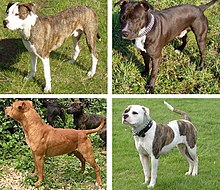| Pit bull | |
|---|---|
 A selection of dog breeds sometimes classified as pit bull types. Clockwise from top left: American Pit Bull Terrier, American Staffordshire Terrier, American Bulldog, Staffordshire Bull Terrier. | |
| Origin | United States |
| Dog (domestic dog) | |
Pit bull is an umbrella term for several types of dog believed to have descended from bull and terriers. In the United States, the term is usually considered to include the American Pit Bull Terrier, American Staffordshire Terrier, American Bully, Staffordshire Bull Terrier, and sometimes the American Bulldog, along with any crossbred dog that shares certain physical characteristics with these breeds. In other countries, including the United Kingdom, the term is used as an abbreviation of the American Pit Bull Terrier breed specifically,[1][2][3] while the Staffordshire Bull Terrier is not considered a pit bull.[1][4][5] Most pit bull–type dogs descend from the British bull and terrier, a 19th-century dog-fighting type developed from crosses between the Old English Bulldog and the Old English Terrier.[6][7][8]
Pit bull–type dogs have a controversial reputation as pets internationally, due to their history in dog fighting,[9] the number of high-profile attacks documented in the media over decades, and their proclivity to latch on while biting. Proponents of the type and advocates of regulation have engaged in a highly contentious nature-versus-nurture debate over whether aggressive tendencies in pit bulls may be appropriately attributed to owners' poor care for and competency to handle the dog or inherent qualities owing to their breeding for fighting purposes.[10] While some studies have argued that pit bull–type dogs are not disproportionately dangerous, offering competing interpretations on dog bite statistics, independent organizations have published statistics based on hospital records showing pit bulls are responsible for more than half of dog bite incidents among all breeds despite comprising only 6% of pet dogs.[11][12]: 18, 49 Some insurance companies will not cover pit bulls (along with Rottweilers and wolf hybrids) because these particular dogs cause a disproportionate rate of bite incidents.[13] Dog bite severity varies by the breed of dog, and studies have found that pit bull–type dogs have both a high rate of reported bites and a high rate of severe injuries, compared to other non–pit bull–type dogs.[14][15]
Pit bull–type dogs are extensively used in the United States for dog fighting, a practice that has continued despite being outlawed.[7][16] Several nations and jurisdictions restrict the ownership of pit bull–type dogs through breed-specific legislation.[1][4] A pro–pit bull lobby exists that spends millions of dollars a year promoting pit bulls as family pets, funding pro-pit bull researchers, and opposing laws that regulate their ownership.[12]: loc 762
- ^ a b c Cite error: The named reference
Hoffmanwas invoked but never defined (see the help page). - ^ Cite error: The named reference
Oxfordwas invoked but never defined (see the help page). - ^ Cite error: The named reference
Websterwas invoked but never defined (see the help page). - ^ a b Cite error: The named reference
Olsonwas invoked but never defined (see the help page). - ^ Cite error: The named reference
Allenwas invoked but never defined (see the help page). - ^ Cite error: The named reference
Foglewas invoked but never defined (see the help page). - ^ a b Cite error: The named reference
Morriswas invoked but never defined (see the help page). - ^ Cite error: The named reference
Beaufoywas invoked but never defined (see the help page). - ^ "The Most Feared Dogs May Also Be the Most Misunderstood". National Geographic News. July 3, 2016. Archived from the original on July 15, 2020. Retrieved August 15, 2020.
- ^ Glazebrook, Louise (April 13, 2016). "What makes an animal dangerous? The nature v nurture debate in dogs". BBC Newsbeat. Archived from the original on October 14, 2019. Retrieved August 15, 2020.
- ^ "The Problem With Pit Bulls". Time. Archived from the original on May 13, 2020. Retrieved August 20, 2020.
- ^ a b Coile, D. Caroline (2021). Pit Bulls for Dummies (2nd ed., Kindle ed.). John Wiley and Sons. ISBN 978-1119720904.
- ^ Gephardt, Bill. Some dog breeds too risky for insurance companies. Archived September 4, 2015, at the Wayback Machine KSL.com, May 8, 2013
- ^ Essig, Garth F.; Sheehan, Cameron (February 2019). "Dog bite injuries to the face: Is there risk with breed ownership? A systematic review with meta-analysis". International Journal of Pediatric Otorhinolaryngology. 117: 182–188. doi:10.1016/j.ijporl.2018.11.028. ISSN 0165-5876. PMID 30579079. S2CID 57740754. Retrieved February 23, 2022.
- ^ Taylor, Jeffrey Q.; Krieger, Rachel (January 13, 2023). "Pediatric Dog Bites to the Face May Have Been Less Severe During COVID-19 Pandemic: A Retrospective Cohort Study". Journal of Oral and Maxillofacial Surgery. 81 (5): 575–582. doi:10.1016/j.joms.2022.12.018. PMC 9838755. PMID 36646135.
- ^ Cite error: The named reference
Kaloufwas invoked but never defined (see the help page).